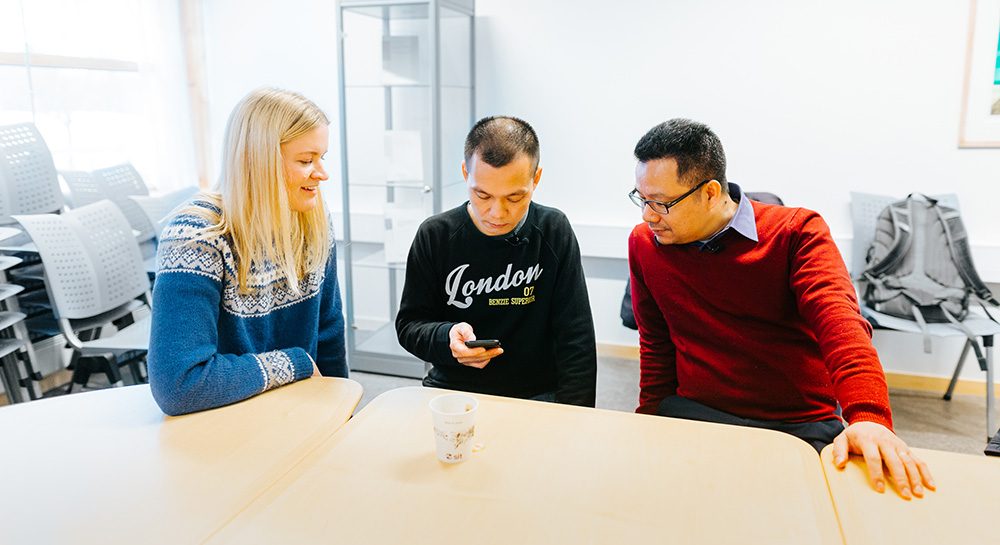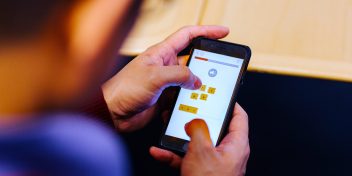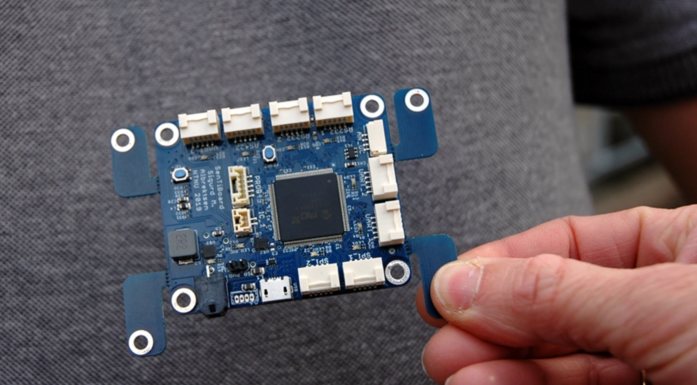Improve your Norwegian with tailor-made language app
Choose from 77 mother tongues and 6 Norwegian dialects. A new app offers customized Norwegian language exercises based on your native language. The newly launched app could prove a useful tool in adult education, too.
“Yes!” exclaims Pham Luong Hung as he strikes a modestly jubilant pose. He’s just outscored his colleague Pham Hien in a spelling exercise of Norwegian words that are particularly difficult for people from Vietnam.
The two language researchers are visiting NTNU in a completely different context, but Marie Jacobsen Lauvås corralled them into testing a new app based on ten years of research at NTNU’s Department of Language and Literature. Lauvås is CEO of the company Sounds Good, which is launching the “Norwegian pronunciation” app.
Hung and Hien are taking a break from their meeting and are hunched over a mobile phone.
“Peis, beis,” says the app voice.
“Should I press here?” asks Hung.
“No, you have to go to the page you think it belongs to,” says Lauvås.
Hung is tackling the first level of exercises on minimal pairs, which are words that differ from one another in only one sound. Hearing a difference between [b] and [p] at the beginning of a word is especially difficult for people with Vietnamese as their native language.
Article continues below photo.

Vietnamese language researchers Pham Luong Hung and Pham Hien test the language app. One the left is Marie Jacobsen Lauvås, CEO of the company Sounds Good that is launching the app “Norwegian pronunciation.” Photo: Julie Gloppe Solem, NTNU
When you open the app for the first time, you select a native language from a list of 77 mother tongues that the app supports. Then you choose which of six variations of Norwegian you want to practise.
Ten years of research
About ten years ago, a teacher in Norwegian for immigrants contacted NTNU Professors Olaf Husby and Jacques Koreman. He wondered if they could develop a smart solution to better tailor the training to each student. Students from Somalia were having challenges with entirely different language sounds than those from China, for example.
“Every newborn is equipped with the potential to learn any language,” says Husby, who works with Koreman in NTNU’s Department of Language and Literature. But in the course of the first six months of life, everything unnecessary is filtered out. The ability to distinguish language sounds disappears, and infants embed sounds into their nervous system so they become automated.
“We have automated systems as adults,” he said, so a Vietnamese person talking Norwegian naturally falls into their automated Vietnamese system.
That’s why people with different mother tongues have different challenges in learning Norwegian. The app “Norwegian pronunciation” is the first language training program in the world that takes these differences into account, according to Sounds Good’s research.
Four types of exercises
The app has four exercise levels. After practising minimal pairs, the student tries to remember different sounds and place them in the proper categories. The next level is a writing exercise. Here, Hung and Hien spell words by choosing from a selection of letters and dragging the right ones onto a line. Hien’s spelling word is stopp. The letter selection also includes two letter f’s. In Vietnamese, you don’t pronounce the letters p or f at the end of a word, so this exercise is a real challenge.
The last exercise requires saying the word.
“Stopp,” says Hung, with a clear final [p] sound.
And here he reveals that he is a phoneticist by training – in other words, an expert in language learning. A typical Vietnamese would really struggle to get the [p] sound at the end of a word.
Husby says a Vietnamese person would pronounce the Norwegian word stopp something like “seto.” But Hung knows that the letter p is a so-called unvoiced aspirated bilabial, and that he has to close his lips and then open them and breathe out afterwards.
Mapped 500 languages
Over the last ten years, Koreman and Husby have put an enormous effort into mapping 500 languages. They identified which language sounds and sound combinations differentiate one language from another. From this step, they could have made a comprehensive list of sounds that are difficult for anyone learning Norwegian. But a list like this would have been extremely long, and no one needs to work on all the sounds on the list.
“We figured out that we could create a database that would filter out the unnecessary sounds by identifying the student’s native language and the variant of Norwegian they wanted to learn,” says Husby.
The researchers broke each word down to its phonemic, or sound, components and developed an algorithm that determines what exercises you need to do if language A is your native language and you want to learn language B.
As Husby explains, “We select language A and language B, and certain colour fields light up on the screen. The computer program goes and collects exercises for any fields that light up red. If you have trouble distinguishing between fot (foot) and fort (fast), for example, the program picks out exercises to practice just that.
Gained momentum with Technology Transfer
But this brilliant little invention could easily have remained an internal secret. Husby readily admits that business acumen is not a dominant part of the culture at the NTNU Dragvoll campus. But the researchers did know how to contact people with those skills. NTNU Technology Transfer (TTO) was able to show that the algorithm could have commercial value.
The company Sounds Good was established, and Lauvås was commissioned to commercialize the technology. The app “Norwegian pronunciation” is the first in a number of products that will come from the NTNU research community and Sounds Good.
“TTO has the expertise to connect good people on the entrepreneurial side with researchers who have the relevant expertise to contribute to a company. Together we can build great values for the future and create products that people out there love – that’s the goal,” says Lauvås, a civil engineering graduate with a master’s degree from the NTNU School of Entrepreneurship.
Users can expect more game elements in the products to come.
“It’s especially exciting that we’ve managed to bring in some game developers who work for Nintendo and Krillbite Studio. They’re able to add the incredibly important component of getting people to engage and play their way to learning,” Lauvås says.
Hope app will be used for teaching
Sounds Good is aiming for their app to be used in adult education throughout Norway. In the municipality of Ski, teacher Christian Hansen has already tested it with some of his students.

People with different mother tongues have different challenges in learning Norwegian. The app “Norwegian pronunciation” is thought to be the first language training program in the world to address these differing needs. Photo: Julie Gloppe Solem, NTNU
“I’ve received only positive responses. The students find the program intuitive, and they recognize its usefulness right away when they can put in their native language and what dialect they want to learn,” says Hansen.
However, the students aren’t yet able to use the app systematically.
“This is an individual app and we have so few iPads that we can’t use it in the classroom. The students want it on their phones, and that will enable them to work on it at home and make it a good supplement to their instruction,” Hansen says.
But Hansen still thinks a mobile app is a smart format.
“Everyone has a smartphone. People take them along everywhere. If the exercises were a program on a PC, they wouldn’t be used in the same way,” he says.
Accents are socially charged
But why is it so important to pronounce Norwegian sounds correctly? Of course it’s important for the words to be pronounced as closely to how the Norwegians speak them as possible. But it’s usually not that hard to understand people even if they speak with a strong accent, is it?
“We know from sociolinguistic research that there’s another layer here,” says Husby.
“People’s pronunciation becomes socially charged when they have an accent. Surveys in Sweden show that if you pronounce the g clearly when you say många (many), people assume you’re less intelligent. People assign personality traits to you. And if you’re in a job setting, you’re considered less qualified,” he says.
In the meeting room on the Dragvoll campus, Hung and Hien have kindly agreed to test the app for another round so the photographer can film a little more.
“I think the app is fascinating. It’s very useful for anyone who wants to try out a new language. I tried some exercises, and I find it very interesting,” says Hung.






